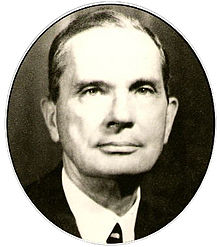- Mark Aitchison Young
-
Sir Mark Aitchison Young 
21st Governor of Hong Kong In office
10 September 1941 – 25 December 1941Preceded by Sir Geoffrey Northcote In office
1 May 1946 – 25 July 1947Succeeded by Sir Alexander Grantham Personal details Born 30 June 1886 Died 12 May 1974 (aged 87) Spouse(s) Josephine Mary Alma mater King's College, Cambridge Profession soldier, colonial administrator Sir Mark Aitchison Young, GCMG (楊慕琦, 30 June 1886 – 12 May 1974) was a British administrator who became the Governor of Hong Kong during the years immediately before and after the Japanese occupation of the territory.
Contents
Early life, service in war
Young was educated at Eton College and King's College, Cambridge. He entered the Ceylon Civil Service in 1909 and served in the British Army with the Rifle Brigade during World War I from 1915.
Colonial administration
Young served as Principal Assistant Colonial Secretary of Ceylon from 1923 to 1928, then as colonial secretary of Sierra Leone from 1928 to 1930. From 1930 to 1933, he served as Chief secretary to the Government of the British Mandate of Palestine.
From 5 August 1933 to March 1938, he served as Governor and Commander-in-Chief of Barbados. From November 1937 to February 1938, he served in the Government of Trinidad and Tobago. Then from 1938 to 1941, he served as Governor and Commander-in-Chief of the Tanganyika Territory British Mandate.
Hong Kong Governor, prisoner of war
He served as Governor of Hong Kong between 1941 and 1947. During his term, which coincided with the Pacific theatre of World War II, Hong Kong came under the threat of Japanese invasion.
At 08:00, 8 December 1941, several hours after Pearl Harbor was attacked, Hong Kong came under fire by Imperial Japanese Forces. The battle lasted for 18 days, and ended when Young surrendered the Colony to the Japanese General Takashi Sakai on 25 December, known as the 'Black Christmas' by Hong Kong people, who were then subject to Japanese rule for the next 3 years and 8 months. Young rebuffed several attempts by General Maltby and others in the military to ask for terms and discuss surrender as early as the 18th. This was in part based on clear instruction by Churchill directly to Young, advising him that "Every Part of (Hong Kong) Island must be fought over and the enemy resisted with the utmost stubbornness. Every day that you are able to maintain your resistance you help the Allied cause all over the world."[1]
Young was a prisoner of war in Japanese hands from December 1941 to August 1945. He was initially held in the Peninsula Hotel and subsequently incarcerated in a prisoner of war camp in Stanley, on the southern shores of Hong Kong Island. Shortly thereafter, he was later transferred, with other high ranking Allied captives including General Maltby, to a series of POW camps in Shanghai, Taiwan, and Japan, then to a camp near the Chinese-Mongolian border, and finally to a location near Mukden (modern Shenyang) Manchuria, until his liberation at war's end. Despite being the colony's highest ranking official, Young was mistreated by his captors. Japan was defeated and surrendered in September 1945 and the British regained control of the colony.
Post-Japanese occupation governorship
Young resumed his duties as Governor of Hong Kong on 1 May 1946, after having spent some time recuperating in England. After returning, he proposed political reforms that would have allowed Hong Kong residents to directly choose a 30-member representative Legislative Council. He envisaged that the new Council would handle everyday affairs and that its decisions would be immune to the Governor's veto. These initiatives were eventually abandoned under the term of Governor Alexander Grantham because of fears of Communist manipulation. Young retired from the governorship in 1947.
Personal life
Young and his wife, Josephine Mary, had two sons and two daughters.
Young, Sir William Robinson and Christopher Patten are the only Governors to not have been honoured in Hong Kong after completing their post.
Honours
- C.M.G., 1931
- K.C.M.G., 1934
- G.C.M.G., 1946
External links
References
- ^ Snow, Philip. [2004] (2004). The fall of Hong Kong: Britain, China and the Japanese occupation. Yale University Press. ISBN 0-300-10373-5, 9780300103731
Government offices Preceded by
Sir John Robert ChancellorHigh Commissioner of Palestine
1931–1932 (acting)Succeeded by
Sir Arthur Grenfell WauchopePreceded by
Harry Scott NewlandsGovernor of Barbados
1933–1938Succeeded by
Sir Eubule John WaddingtonPreceded by
Harold Alfred MacMichaelGovernor of Tanganyika Territory
1938–1941Succeeded by
Wilfrid Edward Francis JacksonPreceded by
Sir Geoffrey NorthcoteGovernor of Hong Kong
1941Succeeded by
Takashi Sakai and Masaichi Niimi
as Governor-General of Hong Kong
Japanese occupation of Hong KongPreceded by
Sir Cecil Harcourt
as Administrator of Hong KongGovernor of Hong Kong
1946–1947Succeeded by
Sir Alexander GranthamGovernor of Hong Kong  Categories:
Categories:- Governors of Hong Kong
- 1886 births
- 1974 deaths
- Governors of Barbados
- British High Commissioners of Palestine
- British Army personnel of World War I
- Rifle Brigade officers
- World War II political leaders
- Hong Kong people of World War II
- Knights Grand Cross of the Order of St Michael and St George
- Old Etonians
- Alumni of King's College, Cambridge
- Colonial Administrative Service officers
- Governors of Tanganyika Territory
Wikimedia Foundation. 2010.
